Preface
Contents
1 Introduction to Acoustics of Phononic Crystals. Homogenization at Low Frequencies
1.1 Introduction
1.2 Homogenization: Quasi-Static Limit and the Method of Plane Waves
1.2.1 One-Dimensional Periodicity
1.2.2 Two-Dimensional Periodicity
1.2.3 Three-Dimensional Periodicity
1.3 Homogenization: The Multiple-Scattering Method
1.3.1 Homogenization of Mixed Lattices
1.3.2 Homogenization of a Medium with Local Resonances
References
2 Fundamental Properties of Phononic Crystal
2.1 Introduction to the Concept of Phononic Crystals and Their Band Structures
2.2 Dispersion Curves and Band Gaps in 2D Phononic Crystals
2.2.1 Origin of the Band Gaps: Bragg Gaps and Local Resonances
2.2.2 Behavior of the Band Gaps as a Function of the Geometrical and Physical Parameters
2.2.3 Solid–Solid Phononic Crystal
2.2.4 Solid–Fluid Phononic Crystal
2.2.5 Fluid–Fluid Phononic Crystal
2.2.6 Locally Resonant Phononic Crystal
2.3 Localized Modes Associated with Defects
2.3.1 Guiding
2.3.2 Filtering
2.3.3 Demultiplexing
2.3.4 Tunability
2.4 Concluding Remarks and Further Developments in the Field of Phononic Crystals
References
3 The Three-Dimensional Phononic Crystals
3.1 Introduction
3.2 Phononic Lattices
3.2.1 Multiple Scattering and the LMS Method
3.2.2 Formation of Omnidirectional Frequency Gaps, Attenuation, and Tunneling
3.2.3 Next-Generation 3D Phononic Structures
3.3 Imperfect Phononic Structures: From Periodicity to Disorder
3.3.1 Layered Non-periodic Heterostructures
3.3.1.1 Planar Defects
3.3.1.2 Gradient Layered Structures
3.3.1.3 Planar Disorder
3.3.2 Linear Defects
3.3.2.1 Multiple Scattering in the Real Space
3.3.2.2 Waveguiding
3.4 Multi-component 3D Phononic Crystals (Locally Resonant and Acoustic Metamaterials)
3.4.1 Locally Resonant Phononic Crystals
3.4.1.1 Bulk Structures
3.4.1.2 Finite Plates
3.4.2 Acoustic Metamaterials
References
4 Computational Problems and Numerical Techniquesfor the Analysis of Phononic Crystals
4.1 Basic Equations for Wave Propagation
4.1.1 Equations for Solids
4.1.2 Equations for Fluids
4.1.3 Consideration of Material Loss
4.2 Computational Problems of Phononic Crystals
4.2.1 Classification by Geometry
4.2.2 Classification by Problem Type
4.3 Multiple Scattering Theory and Layer Multiple Scattering Methods
4.4 Plane Wave Expansion Method
4.4.1 Band Structures with PWE
4.4.2 Evanescent Waves in Phononic Crystals
4.5 Finite Element Method
4.6 Finite-Difference Time-Domain Method
4.6.1 Boundary Conditions
4.6.2 Calculation of Dispersion Relations
4.6.3 Calculation of Transmission Spectra
4.7 Conclusion
References
5 Phononic Crystal Membranes (Slabs or Plates)
5.1 Introduction
5.1.1 A Brief History of the PnC Slab Structures
5.1.2 Problem of Leaky SAWs in PnC Structures
5.2 PnC Slab (Membrane) Structures
5.2.1 Types of PnC Slab Structures Based on Geometry
5.2.2 Inclusion-Based PnC Slabs
5.2.3 Decorated Stubs PnC Membranes
5.2.4 Examples of PnC Slab Structures
5.3 Methods for the Analysis of PnC Slabs
5.3.1 FDTD for the Analysis of PnC Slabs
5.3.1.1 Free Surface Boundary Condition
5.3.2 PWE for the Analysis of PnC Slabs
5.3.3 FE Method for the Analysis of PnC Slabs
5.3.4 Other Significant Techniques for the Analysis of PnC Slab Structures
5.3.4.1 Transfer, Reflection, and Transmission Matrix Methods
5.3.4.2 Scattering Matrix (Modal) Method
5.4 Fabrication and Characterization of PnC Slab Structures
5.5 Case Study: Engineering in PnC Slabs with Void Inclusions
5.5.1 Design of Void/Solid Si PnC Slab Structures with High-Frequency Complete PnBGs
5.5.2 Fabrication and Characterization of Si PnC Slab Structures
5.6 PnC Crystal Slab Devices and Band Gap Engineering
5.6.1 Energy Confinement in MM Resonators in PnC Slabs
5.6.1.1 MM PnC Slab Resonators with Resonant Tunneling Excitation
5.6.2 Support Loss Suppression of MM Resonators Using PnBG Structures
5.6.2.1 Support Loss in MM Resonators
5.6.2.2 A Support Loss Suppressed PnC Slab Resonator
5.6.3 PnC Slab Waveguides
5.6.3.1 An Efficient PnC Slab Waveguide
5.6.4 High-Q Waveguide-Based PnC Resonators
5.7 Further Research Trends and Perspectives of PnC Slab Structures
5.7.1 Dispersive PnC Slab Structures
5.7.2 Optomechanical Crystal Slabs
5.7.3 Thermal Phonons Control in PnC Slabs
References
6 Surface Acoustic Waves in Phononic Crystals
6.1 Introduction
6.2 Theoretical Formulations
6.2.1 PWE Method
6.2.1.1 General Equations
6.2.1.2 Case of Void Inclusions in a Solid Matrix
6.2.2 Finite-Difference Time-Domain Method
6.3 SAWs in Phononic Crystals
6.3.1 Frequency Band Structures
6.3.2 Band Gaps and SAW Characteristics
6.3.3 Bleustein–Gulyaev Waves
6.4 Phononic Crystal Waveguides for SAW
6.4.1 Complete Band Gaps of Steel/Epoxy Phononic Crystals
6.4.2 SAWs Inside a Phononic Crystal Waveguide
6.5 Experiment on the SAW Band Gap
6.5.1 Band Gap for SAWs in Silicon-Based Phononic Crystals
6.5.2 Piezoelectric Phononic Crystals
6.6 Application of SAW Band Gap to SAW Devices
6.6.1 Reflective Grating for SAWs Using Phononic Crystals
6.6.2 SAW Resonator
6.7 Conclusions
References
7 Optical Characterization of Phononic Crystalsin the Time Domain
7.1 Introduction
7.2 Experimental Setup for Scanning Laser Interferometry in the Time Domain
7.2.1 Optical Pump-Probe Technique
7.2.2 Interferometer
7.2.3 Scanning System
7.3 Applications to Phononic Crystals
7.3.1 From Time-Resolved Data to the Acoustic Dispersion Relation
7.3.2 One-Dimensional Phononic Crystals
7.3.3 Two-Dimensional Phononic Crystals
7.3.4 Summary: Capabilities and Limitations
7.4 Conclusions
References
8 Optical Characterization of Phononic Crystalsin the Frequency Domain
8.1 Introduction
8.2 Scanning Laser Interferometry in Frequency Domain
8.2.1 Homodyne Detection
8.2.2 Heterodyne Detection
8.3 Capabilities and Limitations of Scanning Laser Interferometers
8.4 Applications to Phononic Crystals
8.4.1 Surface Acoustic Waves in Micro-Structured Acoustic Metamaterials
8.4.1.1 Extracting Propagation Information from Random SAW Field
8.4.1.2 Two-Dimensional Phononic Crystal for 200MHz SAWs
8.4.2 Bulk Acoustic Waves in Acoustic Metamaterials
8.4.2.1 Thin-Film Mirror Transfer Properties
8.4.2.2 Further Use of Dispersion Diagrams in Data Analysis
8.5 Conclusion
References
9 Future Prospects of Phononic Crystals and PhononicMetamaterials
9.1 Introduction
9.1.1 Timing Elements Using Phononic Crystals
9.1.2 Signal Processing Functions for Communications
9.1.3 Phononic Crystal Sensors
9.1.4 Negative Refraction and Superlensing
9.1.5 Phononic Crystals for Opto-Mechanics
9.1.6 Phononic Crystals for Liquid Control and Handling
9.1.7 Nonlinearity Effects in Phononic Crystals
9.1.8 Energy Scavenging Using Phononic Crystals
9.1.9 Thermal Phonon Control Through the Use of Phononic Crystals
9.1.10 Noise Control and Sound Proofing
9.1.11 Phononic (Acoustic or Thermal) Diodes and Transistors
9.1.12 Immunization to Environmental Variables
9.1.13 Note on Acoustic Metamaterials
9.2 Conclusion
References
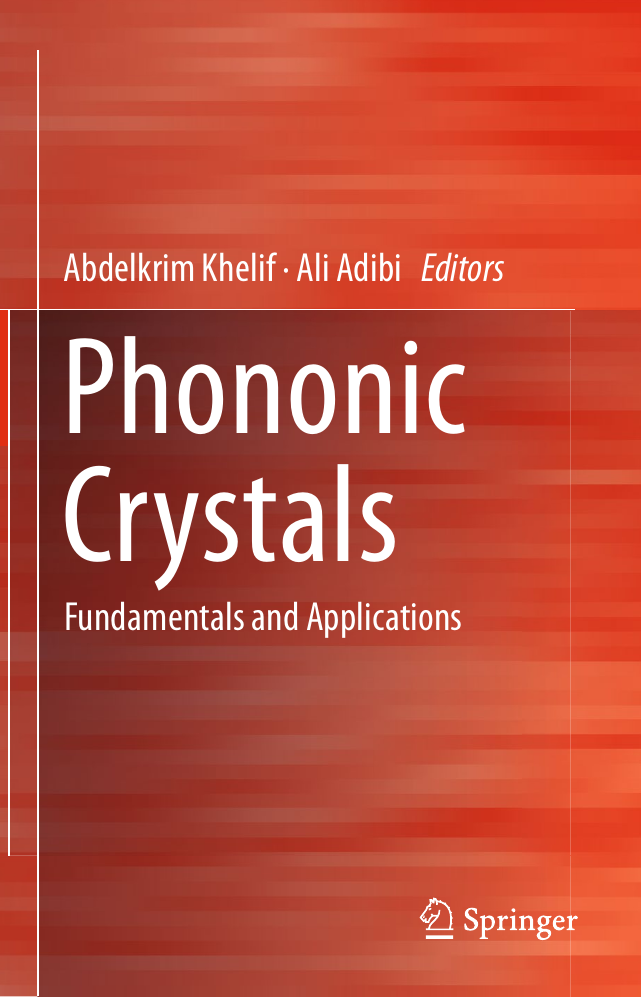


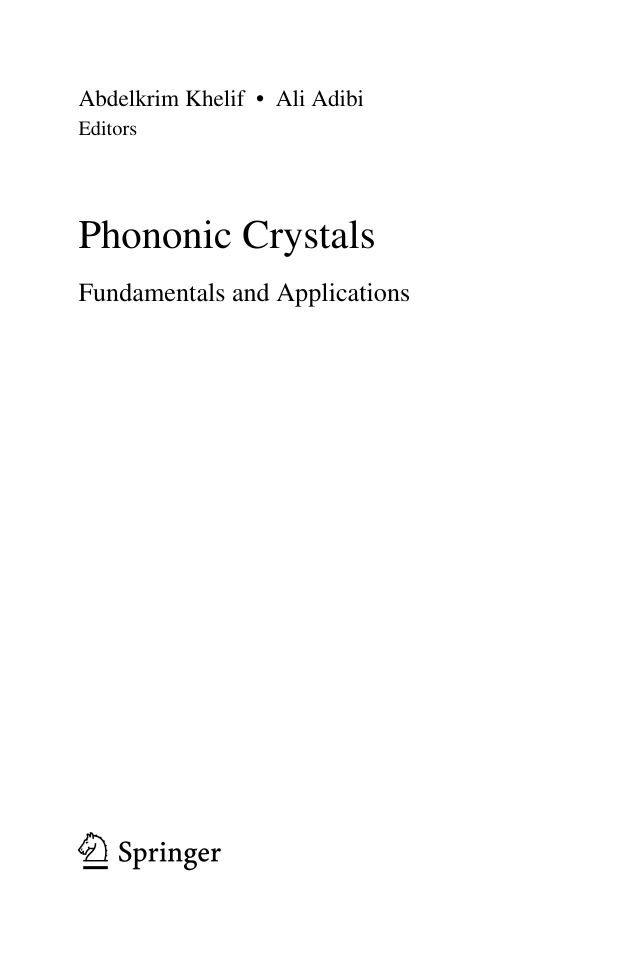
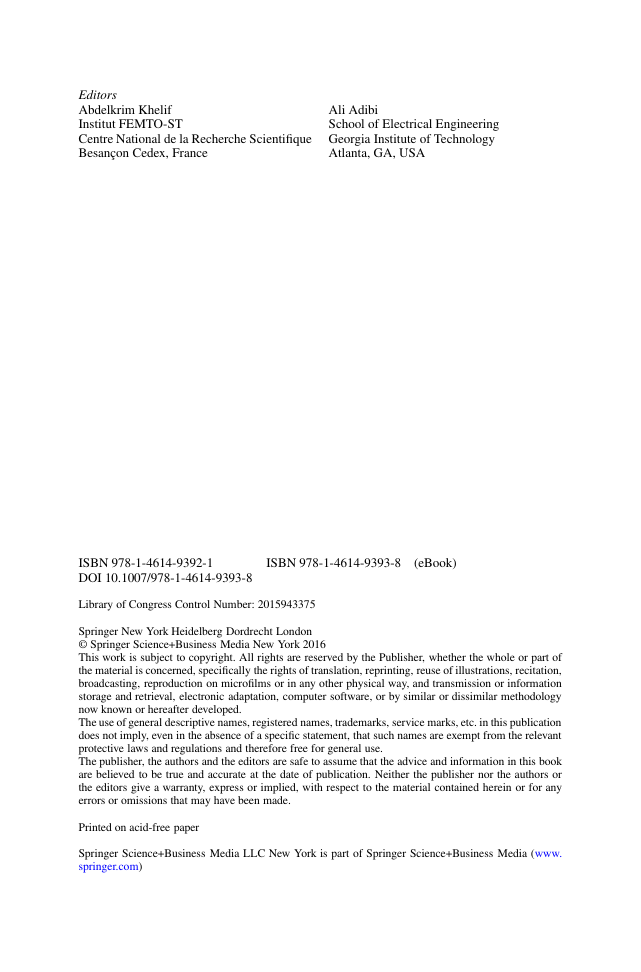
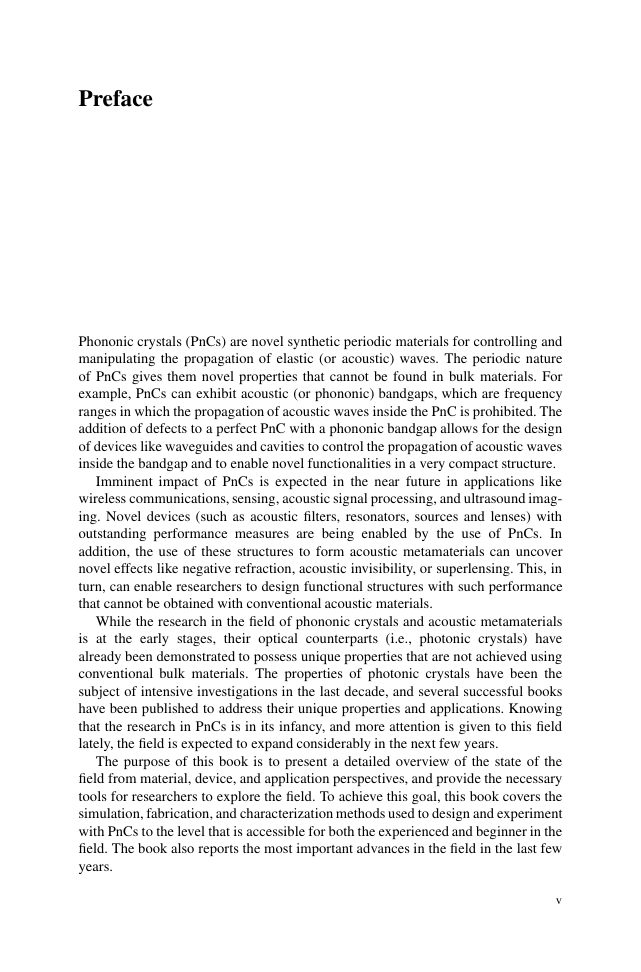
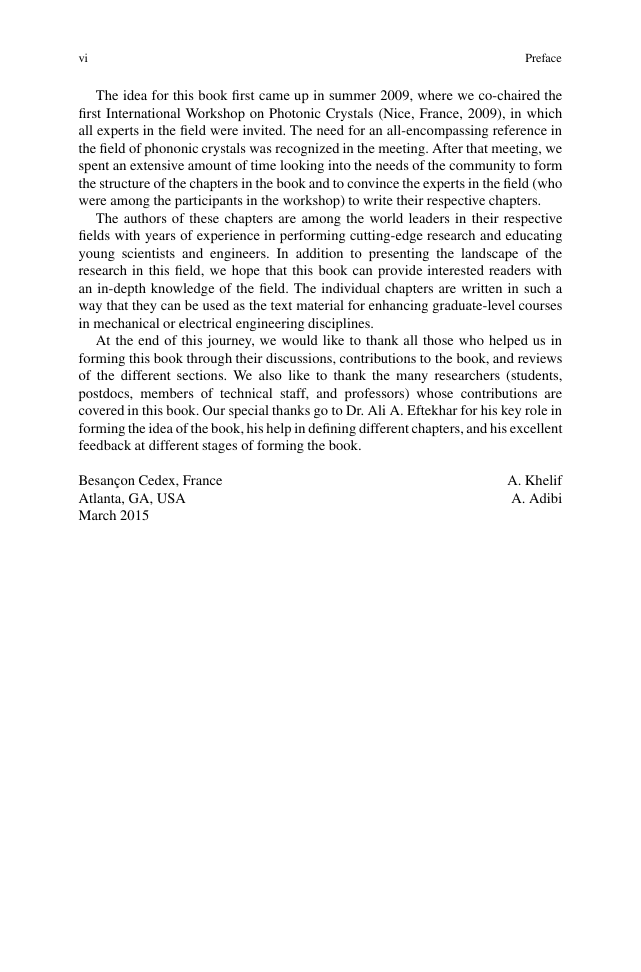









 2023年江西萍乡中考道德与法治真题及答案.doc
2023年江西萍乡中考道德与法治真题及答案.doc 2012年重庆南川中考生物真题及答案.doc
2012年重庆南川中考生物真题及答案.doc 2013年江西师范大学地理学综合及文艺理论基础考研真题.doc
2013年江西师范大学地理学综合及文艺理论基础考研真题.doc 2020年四川甘孜小升初语文真题及答案I卷.doc
2020年四川甘孜小升初语文真题及答案I卷.doc 2020年注册岩土工程师专业基础考试真题及答案.doc
2020年注册岩土工程师专业基础考试真题及答案.doc 2023-2024学年福建省厦门市九年级上学期数学月考试题及答案.doc
2023-2024学年福建省厦门市九年级上学期数学月考试题及答案.doc 2021-2022学年辽宁省沈阳市大东区九年级上学期语文期末试题及答案.doc
2021-2022学年辽宁省沈阳市大东区九年级上学期语文期末试题及答案.doc 2022-2023学年北京东城区初三第一学期物理期末试卷及答案.doc
2022-2023学年北京东城区初三第一学期物理期末试卷及答案.doc 2018上半年江西教师资格初中地理学科知识与教学能力真题及答案.doc
2018上半年江西教师资格初中地理学科知识与教学能力真题及答案.doc 2012年河北国家公务员申论考试真题及答案-省级.doc
2012年河北国家公务员申论考试真题及答案-省级.doc 2020-2021学年江苏省扬州市江都区邵樊片九年级上学期数学第一次质量检测试题及答案.doc
2020-2021学年江苏省扬州市江都区邵樊片九年级上学期数学第一次质量检测试题及答案.doc 2022下半年黑龙江教师资格证中学综合素质真题及答案.doc
2022下半年黑龙江教师资格证中学综合素质真题及答案.doc